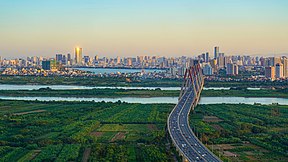
Hanoi
Capital of Vietnam / From Wikipedia, the free encyclopedia
Dear Wikiwand AI, let's keep it short by simply answering these key questions:
Can you list the top facts and stats about Hanoi?
Summarize this article for a 10 year old
Hanoi[lower-alpha 1] (Vietnamese: Hà Nội ⓘ) is the capital and second-most populous city of Vietnam. As evident by the literal translation of its name – 'inside the river'[17] – portions of Hanoi's border are delineated by the Red and Black Rivers. As a municipality, Hanoi consists of 12 urban districts, 17 rural districts, and one district-level town. It has an area of 3,359.84 km2 (1,297.24 sq mi)[3] and a population of 8,435,700 in 2022.[8] In 2020, Hanoi has the second-highest gross regional domestic product of all Vietnam provinces and municipalities at 51.4 billion USD,[18] behind Ho Chi Minh City.[19] Hanoi Capital is also ASEAN 8th largest economy after Surabaya.
Hanoi
Hà Nội | |
|---|---|
| City of Hanoi Thành phố Hà Nội | |
Hanoi's skyline with Nhật Tân Bridge Pilgrimage boat toward Hương Temple | |
| Nicknames: | |
| Motto: Dis lecta fortitudine prospera (historical) | |
 | |
| Coordinates: 21.00°N 105.85°E / 21.00; 105.85 | |
| Country | |
| Region | Red River Delta |
| Founded | 257 BC |
| Founded by | An Dương Vương |
| Seat | Hoàn Kiếm |
| Subdivision | 12 urban districts, 17 rural districts, one district-level town |
| Government | |
| • Type | Municipality |
| • Body | Hanoi People's Council [vi] |
| • Secretary of the Party Committee | Đinh Tiến Dũng |
| • Chairman of People's Council | Nguyễn Ngọc Tuấn |
| • Chairman of People's Committee | Trần Sỹ Thanh |
| Area | |
| • Capital city and municipality | 3,359.84 km2 (1,297.24 sq mi) |
| • Urban | 319.56 km2 (123.38 sq mi) |
| • Metro | 24,314.7 km2 (9,388.0 sq mi) |
| Highest elevation | 1,296 m (4,252 ft) |
| Population (2022)[8] | |
| • Capital city and municipality | 8,435,700 |
| • Rank | 2nd |
| • Density | 2,500/km2 (6,500/sq mi) |
| • Urban | 4,138,500 |
| • Urban density | 13,000/km2 (34,000/sq mi) |
| • Rural | 4,297,100 |
| • Metro | 20,000,000 |
| • Metro density | 820/km2 (2,100/sq mi) |
| Demonym | Hanoian |
| Ethnic groups | |
| • Vietnamese[12] | 98.66% |
| • Mường | 0.77% |
| • Tày | 0.24% |
| • Thái | 0.09% |
| • Nùng | 0.08% |
| • Others | 0.16% |
| GDP[13] | |
| • Capital city and municipality | US$ 54.04 billion |
| • Metro | US$ 95.5 billion |
| Time zone | UTC+07:00 (ICT) |
| Postal code | 10000–14000 |
| Area codes | 24 |
| ISO 3166 code | VN-HN |
| License plate | 29 – 33, 40 |
| HDI (2020) | 0.799 (1st)[14] |
| Climate | Cwa |
| International airports | Nội Bài International Airport |
| Largest district by area | Ba Vì District (421.80 km2)[15] |
| Largest district by population | Hoàng Mai District (540,732)[16] |
| Website | hanoi.gov.vn |
In the third century BCE, the Cổ Loa Capital Citadel of Âu Lạc was constructed in the area of modern-day Hanoi. Âu Lạc then falls under China rule for around a thousand years. In 1010, Vietnamese emperor Lý Thái Tổ established the capital of the imperial Vietnamese nation Đại Việt in modern-day central Hanoi, naming the city Thăng Long (literally 'Ascending Dragon'). In 1428, king Lê Lợi renamed the city to Đông Kinh (東京), and remained being so until 1789. The Nguyễn dynasty in 1802 moved the national capital to Huế and the city was renamed Hanoi in 1831. It served as the capital of French Indochina from 1902 to 1945. After the August Revolution, the Democratic Republic of Vietnam designated Hanoi as the capital of the newly independent country. In 2008, Hà Tây Province and two other rural districts were annexed into Hanoi, effectively tripling Hanoi's area.
In the 21st century, Hanoi is the cultural, economic and education center of Northern Vietnam. As the capital of the country, Hanoi hosts 78 foreign embassies, the headquarter of People's Army of Vietnam, its own Vietnam National University system, and many other governmental organs. Hanoi is also a major tourist destination, with 18.7 million domestic and international visitors in 2022.[20] The city hosts Imperial Citadel of Thăng Long (an UNESCO World Heritage Site), Ho Chi Minh Mausoleum, Hoàn Kiếm Lake, West Lake, and Ba Vì National Park near the outskirts of the municipality. Hanoi's urban area has a wide range of architectural styles, including French colonial architecture, brutalist apartments typical of socialist nations and disorganized alleys–tube houses reflecting the city's rapid growth in the 20th century. As of early 2020s, many urban amenities in Hanoi are under heavy construction, such as the 8-lines Hanoi Metro and numerous housing estates.







